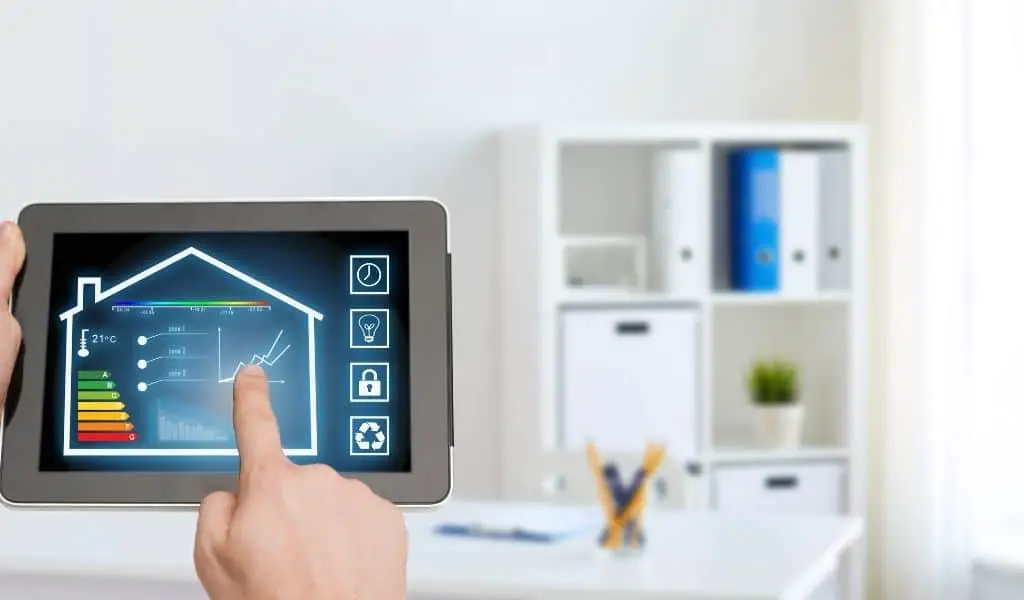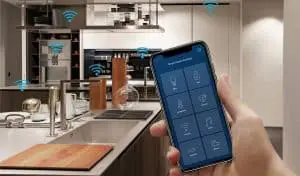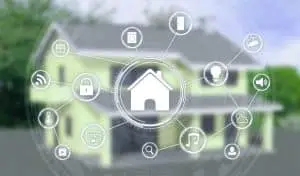There are few things in life that don’t come with pros and cons, the smart home is no exception. In this guide, I’ll explore the advantages and disadvantages of the smart home.
The main advantages of a smart home include convenience, energy efficiency, accessibility, and security. Not to mention the fun you can have with them. Whilst there are also disadvantages such as reliance on the internet and cost, on balance the pros outweigh the cons.
Keep reading for a full explanation of these points as well as details on how smart home manufacturers are working to overcome the negative points.
- Advantages of Smart Homes
- Disadvantages of Smart Homes
- 1. Smart homes can be expensive
- 2. Smart home systems can be over-reliant on the internet
- 3. There's a learning curve for some people
- 4. Smart devices don't always work as they should
- 5. Technology is always changing
- 6. Privacy concerns
- 7. Security issues such as hacking
- 8. Compatibility between devices still isn't universal
Advantages of Smart Homes
Let’s begin by taking a look at the main advantages of a smart home:
1. Added convenience
Perhaps the biggest advantage of a smart home is the extra convenience that it offers to users. Most smart homes will centre around a central hub or smart speaker that can be used to control the home with your voice.
This allows you to turn on lights, change what’s playing on your TV, or even open the garage door, all hands-free and without the need to stop what you’re doing.
2. Smart homes can improve energy efficiency
Smart home devices can be used to help improve the efficiency of your home, saving you money and helping the environment.
One of the best smart devices for saving energy is the smart thermostat. This can be used to adjust temperatures easily on the go and they can learn your schedule to heat your home more efficiently.
They can integrate with other cameras and motion sensors to lower the temperature when you’re vacant. Tado, a leading smart thermostat maker, says they can cut your energy usage by up to 31%.
Other ways that smart homes can improve energy efficiency are:
- Install smart meters to keep an eye on energy consumption.
- Use smart plugs to turn off your appliances each night without having to visit every single plug socket.
- Many companion apps will now report on the energy usage of smart devices which can help you reduce your footprint.
Of course, many smart devices will require energy themselves which might offset some of the savings but generally you’ll be able to reduce your bills and consumption overall.
3. They are great for elderly and disabled people
The smart home revolution is making things much more accessible for elderly and disabled people. Whilst not having to leave your chair to turn a light on might be a small win for many of us, for those who are unable to leave their chair it’s a life-changer.
People who are bed/chair-ridden and those who are blind are set to gain the most from the smart home thanks to voice control of all their home appliances.
The benefits are endless, for example, robot vacuums can reduce the amount of cleaning required, a smart doorbell allows you to speak with your visitor from the sofa, and smart locks give you control of the doors.
Those who are deaf can also benefit from a smart home thanks to advanced routines and home automation. For example, you can have your lights turn red when the smoke alarm is triggered or have your TV pop up with a notification when the doorbell rings.
4. You customise your smart home to suit your needs
The benefit of smart homes is that you can build them to be as simple or as advanced as you wish.
This means you can start off small with just a few devices and eventually grow it to encompass your whole home.
You can choose which smart ecosystem is best for you and build your smart home around your preferred voice assistant such as Siri, Alexa, Google Assistant, Cortana, Bixby, and more.
5. Improve your home security
Another huge advantage of smart homes is that they make home security much more affordable and accessible. You no longer need to use a professional monitoring company to take care of your security needs, install a smart security system and get alerts to your phone when unusual activity is detected.
Devices such as video doorbells are ideal for anyone wanting to add extra security to their front door. This is the smart equivalent of a peephole but allows you to answer the door or check in on your doorstep from wherever you are in the world.
You can also link your outdoor smart lights with cameras or motion sensors to scare away potential intruders.
6. There are many safety benefits of smart homes
On a similar note to security, smart homes can also improve your safety in numerous ways. Connected smoke alarms can alert you via an app when smoke is detected and you can integrate them with smart speakers or smart bulbs to ensure the whole home is aware.
If you’re worried that you’ve left your appliances on at home, you can check in on your smart device in the app to ensure they are turned off. You can also use smart plugs to achieve a similar thing for smaller electrical devices like hairdryers and straighteners.
Other safety benefits of smart homes could include:
- Lighting up walkways at night.
- Turning your electricals off at night.
- Alerting you if a door/window is left open at night.
7. Building a smart home is fun
The final advantage I’ll touch on is the fun aspect. This is less quantifiable than the other points, but still can’t be ignored and underpins the growth of smart homes.
The smart home market is driven by first adopters, these are people like myself that are keen to get their hands on the latest and greatest technology. People who love technology are enjoy automating their homes are often willing to pay more for new technology which pushes manufacturers to keep innovating.
It can often take many years for newer technologies to become mainstream so it’s the enthusiasts and hobbyists that drive these new innovations in the short term.
Disadvantages of Smart Homes
To give a balanced view lets now take a look at some of the disadvantages of smart homes:
1. Smart homes can be expensive
The most obvious disadvantage to smart homes is the added cost of the technology. A smart device will typically cost between 2-20 times the price of an equivalent dumb device.
As an example:
Philips white LED bulbs cost around £12 for a pack of 6, whereas a Philips Hue smart white LED bulb costs £20 for 2, that’s five times the price, plus you’ll need to invest in a Hue Bridge to control them which adds a further £40.
In addition to this, some devices require ongoing subscriptions to access all of the features. This is very common with security devices such as video doorbells and security cameras which require paid cloud storage plans to make use of all their features.
There’s a growing market for security cameras and video doorbells without subscriptions which budget manufacturers such as Eufy are aiming to fill.
2. Smart home systems can be over-reliant on the internet
One problem with smart homes compared to older home automation systems is the reliance on an active internet connection. This is because commands are fed back to the cloud where they are processed and the relevant devices will then be instructed what to do.
All automations such as Google Home or Alexa routines are usually managed from the cloud too. This means that a loss of internet can bring your whole smart home to a halt.
Some of the major brands are working on ways to overcome this such as Amazon’s Alexa and Samsung’s Smart Things. For example, Amazon has baked some basic offline voice commands into their newer Echo smart speakers which allows you to use Alexa offline for turning lights on/off, updating your alarms, and controlling smart plugs.
For those of us that are more tech-savvy, there are ecosystems that have been developed to work better offline such as Hubitat and Home Assistant. However, I wouldn’t recommend these for beginners.
3. There’s a learning curve for some people
The next disadvantage of a smart home is the learning curve that is required. If you’re investing in smart home technology, then chances are that you are technically minded. However, if you live with others who are not so savvy, it can take a while to get used to things.
Smart devices are becoming easier to use and set up. Most major brands are working to ensure their devices can easily be added to your existing ecosystem and included within your daily routines.
4. Smart devices don’t always work as they should
I doubt there is anyone with a smart home that hasn’t encountered issues with technology not working as it should, I certainly have had my fair share.
Sometimes devices just don’t want to work and it can be hard to diagnose the problem. This is because there are so many factors at play including the device itself, the companion app, the Wi-Fi connection, and any integrations with a smart hub or other smart home products.
5. Technology is always changing
Technology is constantly evolving so your smart home devices can become quickly outdated and need to be replaced more often than the equivalent ‘dumb’ devices.
Manufacturers have a lot of control over which features to add or remove in future, so your favourite feature could one day be dropped and there is little you can do.
An example of this is the popular IFTTT (If This Then That) service which had long been a fan favourite for allowing device to talk to each other when they don’t have native for support.
This free service was embedded at the heart of many smart homes until they unexpectedly limited the free service to 3 devices and demanded a monthly subscription from users or they had to find a new service to use.
6. Privacy concerns
Privacy has become a huge factor when it comes to technology and this also reaches to smart devices. We are trusting large technology brands with our daily routines, location, shopping behaviour, and more.
There are many laws that govern the use of our private data, not least the data protection act and newer GDPR laws that govern data usage in Europe.
Privacy is often the trade-off we make for convenience, for example, if Google Assistant knows where we live and work, it can provide updates on our commute and any traffic delays.
7. Security issues such as hacking
I mentioned security as one of the advantages earlier on, so you might be wondering how it is also a disadvantage. This is because smart technology address many of the security issues that ‘dumb’ devices present, but then introduces newer security risks.
One example is hacking. It has already been proven that smart home gadgets can occasionally be hacked giving hackers access to peoples devices. Whilst these occurrences are very rare and are often patched up immediately by manufacturers, it’s still a risk that’s worth keeping in mind.
On balance, smart home devices do seem to be safer. For example, it’s much harder for someone to learn how to hack a smart lock than it is for a thief to pick a traditional door lock.
8. Compatibility between devices still isn’t universal
Smart homes rely on devices talking to each other in order to provide useful features to users. Whilst compatibility between devices is improving, it’s still a downside to smart homes right now.
There have been attempts to create unified standards, one example is the Zigbee Alliance which brings together a number of manufacturers such as Samsung, Philips Hue, Huawei, Tuya, Somfy, and more to create open universal standards. However, there are some brands that make it very difficult to integrate devices such as Apple with their HomeKit.
Tha being said, things are set to dramatically improve with a new standard called project CHIP. This brings together the Zigbee Alliance members with Amazon, Apple and Google to create a unified protocol that will make it easier for devices to talk to each other.



